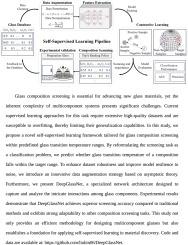玻璃成分筛选的自监督学习
IF 9.3
1区 材料科学
Q1 MATERIALS SCIENCE, MULTIDISCIPLINARY
引用次数: 0
摘要
玻璃成分筛选对于推进新型玻璃材料至关重要,但多组分系统固有的复杂性提出了重大挑战。目前用于该任务的监督学习方法严重依赖于大量高质量数据,并且容易对噪声样本进行过拟合,这限制了它们的泛化能力。在这项工作中,我们提出了一种新的自监督学习框架,专门用于在预定义的玻璃转变温度范围内筛选玻璃成分。我们将筛选任务重新定义为一个分类问题,旨在预测给定组分的玻璃化转变温度是否落在目标区间内。为了提高模型对噪声的鲁棒性,我们引入了一种基于渐近理论的创新数据增强策略。此外,我们提出了DeepGlassNet,这是一种专用的网络架构,用于捕获和分析玻璃成分中组成元素之间的复杂相互作用。实验结果表明,与传统方法相比,DeepGlassNet的筛选精度更高,并且对其他与成分相关的筛选任务具有较强的适应性。本研究不仅为多组分玻璃的设计提供了有效的方法,而且为在材料发现中应用自监督学习奠定了基础。代码和数据可在:https://github.com/liubin06/DeepGlassNet。本文章由计算机程序翻译,如有差异,请以英文原文为准。


Self-supervised learning for glass composition screening
Glass finds broad application across optoelectronics, biomedical engineering, and architectural engineering, but the inherent complexity inherent to multicomponent systems creates substantial challenges in the screening of glass compositions with target properties. Current supervised learning methods for this task rely heavily on large amounts of high-quality data and are prone to overfitting on noisy samples, which limits their generalization ability. In this work, we propose a novel self-supervised learning framework designed specifically for screening glass compositions within pre-defined glass transition temperature ranges. We reformulate the screening task as a classification problem, aiming to predict whether the glass transition temperature of a given composition falls within a target interval. To improve the model’s robustness to noise, we introduce an innovative data augmentation strategy grounded in asymptotic theory. Additionally, we present DeepGlassNet, a dedicated network architecture developed to capture and analyze the complex interactions among constituent elements in glass compositions. This architecture is integrated into our self-supervised framework to optimize the Area Under Curve (AUC) classification metric. Experimental results demonstrate that DeepGlassNet achieves superior screening accuracy compared to traditional methods and exhibits strong adaptability to other composition-related screening tasks. This study not only provides an efficient methodology for designing multicomponent glasses but also establishes a foundation for applying self-supervised learning in material discovery. Code and data are available at: https://github.com/liubin06/DeepGlassNet.
求助全文
通过发布文献求助,成功后即可免费获取论文全文。
去求助
来源期刊

Acta Materialia
工程技术-材料科学:综合
CiteScore
16.10
自引率
8.50%
发文量
801
审稿时长
53 days
期刊介绍:
Acta Materialia serves as a platform for publishing full-length, original papers and commissioned overviews that contribute to a profound understanding of the correlation between the processing, structure, and properties of inorganic materials. The journal seeks papers with high impact potential or those that significantly propel the field forward. The scope includes the atomic and molecular arrangements, chemical and electronic structures, and microstructure of materials, focusing on their mechanical or functional behavior across all length scales, including nanostructures.
 求助内容:
求助内容: 应助结果提醒方式:
应助结果提醒方式:


